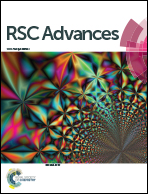Glucose induced variation of water structure from temperature dependent near infrared spectra
Abstract
Water structure variation induced by carbohydrates is a fundamentally important problem in the fields of chemistry and biology for the understanding of life processes. The structural variation of water with concentration and temperature was investigated using temperature dependent near infrared (NIR) spectra of glucose solutions following the concept of aquaphotomics and the results obtained using terahertz (THz) spectroscopy. The spectra were processed using a continuous wavelet transform (CWT), from which the presence of different water species in solutions was confirmed. To further analyze the water structure, Gaussian fitting of NIR spectra was performed using a genetic algorithm optimization. Spectral components relating to six water species were obtained. Through the variation of these species with temperature, the breaking of the hydrogen bonds in water structures was observed. On the other hand, through the variation of these structures with glucose concentration, interactions between the solute and water molecules, as well as the enhancement of the ordered (tetrahedral) hydrogen bonded cluster induced by the interactions, were found. Comparing with the results obtained using THz spectroscopy, the hydration effect is revealed in high concentration solution. Therefore, the glucose in aqueous solution makes the water structure more ordered. This may be the reason for the bioprotective function of carbohydrates.


 Please wait while we load your content...
Please wait while we load your content...